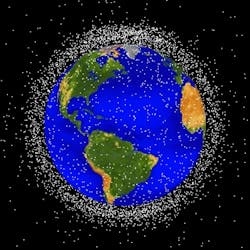Raytheon, Lockheed Martin get go-ahead to design Space Fence S-band space-surveillance radar
HANSCOM AIR FORCE BASE, Mass., 27 Jan. 2011.Space surveillance experts at the U.S. Air Force Electronic Systems Center (ESC) at Hanscom Air Force Base, Mass., are awarding two separate $107 million contracts to the Raytheon Integrated Defense Systems segment in Sudbury, Mass., and to the Lockheed Martin Corp. Mission Systems & Sensors (MS2) segment in Moorestown, N.J., to do preliminary designs for the Space Fence S-band radar system to detect orbiting space objects.
The Space Fence, which will replace the Air Force Space Surveillance System (AFSSS) VHF radar, will have a modern, net-centric architecture that is capable of detecting much smaller objects in low- and medium-Earth orbit (LEO/MEO) than AFSSS VHF, and will be designed to enhance U.S. space situational awareness.
Air Force ESC announced the two separate $107 million contracts to Raytheon and Lockheed Martin on Wednesday. The two companies, as well as the Northrop Grumman Corp. Electronic Systems segment in Linthicum, Md., were involved in Phase A of Space Fence development. The Space Fence project is expected to be worth $3.5 billion, Air Force officials say.
The Space Fence will use several transmitters and receivers create a narrow continent-wide planar energy field in space to detect satellites passing through the energy field to maintain a constant surveillance of space and provide satellite data.
Air Force Space Command at Peterson Air Force Base, Colo., uses the current AFSSS to conduct space surveillance with a network of radar stations located on a great circle across the Southern U.S. Radar data from the surveillance system is networked to the Mission Processing System (MPS) in Dahlgren, Va.
The nine AFSSS sites are located on a path from Georgia to California along the 33rd parallel. The main transmitting station is at Lake Kickapoo, Texas. Two other transmitting stations are at Jordan Lake, Ala., and Gila River, Ariz. Receiver stations are at Tattnall, Ga.; Hawkinsville, Ga.; Silver Lake, Miss.; Red River, Ark.; Elephant Butte, N.M.; and San Diego.
Initial operational capability (IOC) of the Space Fence is expected around 2014. For more information contact Air Force ESC online at www.hanscom.af.mil, Raytheon Integrated Defense Systems at www.raytheon.com, or Lockheed Martin MS2 at www.lockheedmartin.com/ms2.
